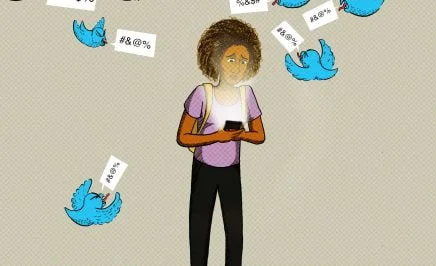Violence and abuse is widespread online, particularly against women. Here are some tips on what you can do if you experience abuse or see someone else experiencing it.
1. Identify abuse
Online violence and abuse has become a far too common experience. And women suffer most. Our online poll found that 23 per cent of women across eight countries had experienced online abuse or harassment on social media platforms.
Online abuse takes many forms, including threats of violence, discrimination, harassment, doxxing (revealing personal or identifying documents) and sharing sexual and private images without consent. It can also include content that is sexist, racist, homophobic or targets someone’s identity.
2. Report them
Everyone will deal with violence and abuse online differently. But whether the abuse is directed at you or someone else, the first step you can take is to report abuse to the platform. Twitter’s own rules say that hateful conduct and abuse is prohibited on the platform and reporting such content can help make sure other users don’t see it in the future.
Reporting abuse can also be helpful when an official police complaint is made. Twitter tells you how reports of abuse on the platform can be downloaded for evidence.
Find out how to report abuse on Facebook and Instagram.
3. Mute them
Most social media platforms give you the option to mute accounts without blocking or unfollowing them.
Here’s how to mute an account on Twitter. Advanced muting options* on Twitter allow for words and hashtags to be muted – this is helpful for people who may be triggered by specific words or references to abusive content on the platform.
You can also mute a person’s posts on Facebook. By doing this, you’ll hide that person’s posts from your newsfeed without having to take the drastic step of unfriending them.
*Advance muting on Twitter means that you may not be able to receive non-abusive content and opportunities to interact with other users on the platform. This function can also prevent you from knowing if you have become a target of violence and abuse on the platform from people you have muted.
4. Block them
There will be times when reporting and muting accounts is just not enough. This is where blocking comes in. Most social platforms will allow you to block offending accounts so that they can no longer interact with you or view your content when they are logged on.
Here’s how to block accounts on Twitter. Remember that although blocking accounts removes the Tweets from your feed and limits the ability of blocked users to directly interact with you – it does not stop blocked users from mentioning your name in abusive Tweets or abusing others.
Find out how to block abusive accounts on Facebook and Instagram.
5. Disable your location
Disabling your location on your social platforms is an important way to protect yourself online. Disabling your location may be useful as it means that people will be less able to easily monitor or track your whereabouts or activities.
If you are using Twitter, Instagram and Facebook on your mobile, you have the option to enable or disable your location for each Tweet or post.
Here’s how to disable location services on Facebook and Instagram.
6. Disable location on your photos
Smartphones store metadata in your photographs, including the location. If your location services are turned ‘on’ for your camera and you post an image to your social media account the image can be used to pinpoint your location, even if you’ve turned off location services. To protect your location you can choose to disable location for all services like images, videos, or any platform you are posting images to.
7. Setting a strong password
This is online protection 101.
Use a new, different, password for each social media site you use. Reusing the same password across lots of sites means that only one of those sites has to get hacked to put your digital identity at risk.
Most people find ‘passphrases’ easier to remember than passwords – here is a good approach to picking passwords and phrases that are strong and easy to remember.
8. Two factor authentication
A good way to help avoid your account being hacked is to enable two factor authentication on all of your social media accounts. In doing this, you’ll be adding another layer of security to your account.
You can set this up by going to your privacy settings in your Twitter account and your security and login settings on Facebook.
9. Filter notifications
You can choose to filter any notifications you receive from users on Twitter. For example, you can choose to not receive notifications from accounts that you don’t follow on Twitter.
Remember, filtering your notifications means that you will not be notified if you have become a target of abuse by someone you do not follow.
10. “I don’t like this Tweet”
You can also mark individual Tweets as “I don’t like this Tweet”. This enables Twitter to understand what you would rather not see in your feed and can help tailor a better experience.
11. Make your account private
By default, your social media accounts are public. You do, however, have the option to restrict your Facebook account to friends only, protect your Tweets and set your photos and videos to private on Instagram.
By making your accounts private, only your approved followers can see your Tweets and posts and interact with you. It’s worth remembering, though, that your current profile and cover photos on Facebook are always public, even if your account is private.
12. Detox
While maintaining your online presence may be necessary, it is also important to keep in mind that online abuse can have a harmful psychological impact and it can be easy to feel overwhelmed by the abuse.
When experiencing abuse or seeing others experience abuse online, a digital detox can be just the thing you need. Taking regular breaks and time away from social media can be helpful.
Most social media platforms allow users to temporarily or permanently deactivate their account, with each platform giving detailed instructions on how to do that. Find out how to deactivate your Facebook, Twitter and Instagram accounts.
13. Useful resources
You can find out more about protecting yourself online by checking out the resources on Hollaback!, Feminist Frequency and Women’s Media Center.




